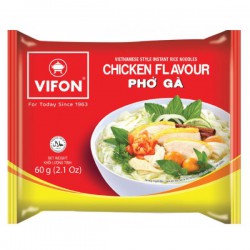Derfor har over 21.000 handlet her
Rice Noodles
Rice noodles
As the name already reveals, rice noodles are simply noodles made from rice. Most packages list two ingredients: rice and water. Certain types of noodles have had a form of starch added, either cornstarch or tapioca starch, which helps improve the noodles' translucency and their texture when eaten. The starch makes the noodles chewier.
Rice and noodles — the story behind
The history behind rice noodles is actually quite interesting. It arose during the Qin dynasty in China, which ruled from 221 to 206 BC, when there was an invasion of southern China from the northern regions. Up in the north the climate was somewhat colder, and they grew wheat and millet there. The wheat and millet were used to make, among other things, noodles, which the northern Chinese were very fond of. However, the weather in the south was not suitable for growing either wheat or millet, where instead there was a tradition of cultivating rice — a crop that thrives in warmer climates. To satisfy the northern Chinese people’s need for noodles, they set their cooks to make noodles from the ingredient available to them: namely rice. Over time rice noodles were developed into the varieties we know today. For example, all moisture has been removed by drying, which significantly extends the noodles’ shelf life.
Rice noodles and rice vermicelli
Rice noodles are not just rice noodles, and the word covers a range of different variants that each have their own unique characteristics. Often there are differences in thickness and width, which are the easiest things to change given the short list of ingredients. The Vietnamese Bánh canh — Vietnamese thick noodle soup (literally "cake soup") is one of the broader varieties commonly used in flavorful soups. "Bánh phở" — "pho noodles" (rice noodles used in the Vietnamese dish phở). is the name of Vietnam's national dish, which is also a soup. Rice noodles are also included here, but these are thinner than Bánh canh. (Vietnamese thick noodle soup). There are also different types of rice noodles that are even thinner than the two aforementioned varieties. Rice vermicelli is one of the thinnest versions of these noodles and is used in many different Asian cuisines. The noodles are used in everything from soups and salads to stir-fries.
Rice noodles as a gluten-free alternative.
One of the clear advantages of rice noodles is that they do not contain gluten. Therefore they can be a natural alternative to wheat noodles, which, as is well known, do contain gluten. Rice-based products are typically a popular alternative for many who suffer from celiac disease or who for other reasons want to avoid gluten. The most noticeable difference will be the texture, where rice noodles do not have the same bite as wheat noodles. If you're looking for rice noodles that closely resemble wheat noodles, it can be a good idea to look for varieties that contain starch. These will have a slightly different texture and consistency that can be much closer to classic wheat noodles.
At the same time, the short ingredient list also makes the noodles a product that doesn't hide many nutritional surprises. There are no hidden flavor enhancers, E-numbers or the like.

 EN
EN
 DA
DA
 ZH
ZH












